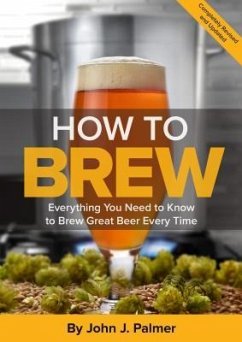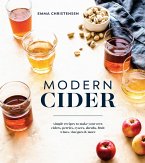John J. Palmer
How to Brew: Everything You Need to Know to Brew Great Beer Every Time
27,99 €
inkl. MwSt.
Versandfertig in 2-4 Wochen

14 °P sammeln
John J. Palmer
How to Brew: Everything You Need to Know to Brew Great Beer Every Time
- Broschiertes Buch
- Merkliste
- Auf die Merkliste
- Bewerten Bewerten
- Teilen
- Produkt teilen
- Produkterinnerung
- Produkterinnerung
"How to Brew is a fully revised and updated do-it-yourself guide to making quality beers at home. Written for all skill levels--from beginners to accomplished all-grain brewers--this book includes ingredients, methods, recipes, equipment suggestions, andbrewing techniques"--
Andere Kunden interessierten sich auch für
![Make Your Own Beer: A Guide to All Things Beer and How to Brew It Yourself Make Your Own Beer: A Guide to All Things Beer and How to Brew It Yourself]() John ShepherdMake Your Own Beer: A Guide to All Things Beer and How to Brew It Yourself22,99 €
John ShepherdMake Your Own Beer: A Guide to All Things Beer and How to Brew It Yourself22,99 €![Stuff Every Beer Snob Should Know Stuff Every Beer Snob Should Know]() Ellen GoldsteinStuff Every Beer Snob Should Know17,99 €
Ellen GoldsteinStuff Every Beer Snob Should Know17,99 €![Brew it Yourself Brew it Yourself]() Richard HoodBrew it Yourself26,99 €
Richard HoodBrew it Yourself26,99 €![Brew It Yourself Brew It Yourself]() Richard HoodBrew It Yourself22,99 €
Richard HoodBrew It Yourself22,99 €![Tasting Beer Tasting Beer]() Randy MosherTasting Beer13,99 €
Randy MosherTasting Beer13,99 €![Modern Cider: Simple Recipes to Make Your Own Ciders, Perries, Cysers, Shrubs, Fruit Wines, Vinegars, and More Modern Cider: Simple Recipes to Make Your Own Ciders, Perries, Cysers, Shrubs, Fruit Wines, Vinegars, and More]() Emma ChristensenModern Cider: Simple Recipes to Make Your Own Ciders, Perries, Cysers, Shrubs, Fruit Wines, Vinegars, and More26,99 €
Emma ChristensenModern Cider: Simple Recipes to Make Your Own Ciders, Perries, Cysers, Shrubs, Fruit Wines, Vinegars, and More26,99 €![Wood & Beer Wood & Beer]() Dick CantwellWood & Beer22,99 €
Dick CantwellWood & Beer22,99 €-
-
-
"How to Brew is a fully revised and updated do-it-yourself guide to making quality beers at home. Written for all skill levels--from beginners to accomplished all-grain brewers--this book includes ingredients, methods, recipes, equipment suggestions, andbrewing techniques"--
Hinweis: Dieser Artikel kann nur an eine deutsche Lieferadresse ausgeliefert werden.
Hinweis: Dieser Artikel kann nur an eine deutsche Lieferadresse ausgeliefert werden.
Produktdetails
- Produktdetails
- Verlag: Brewers Publications
- Fourth Edition
- Seitenzahl: 582
- Erscheinungstermin: 1. Juni 2017
- Englisch
- Abmessung: 253mm x 180mm x 35mm
- Gewicht: 1018g
- ISBN-13: 9781938469350
- ISBN-10: 1938469356
- Artikelnr.: 46498893
- Herstellerkennzeichnung
- Libri GmbH
- Europaallee 1
- 36244 Bad Hersfeld
- gpsr@libri.de
- Verlag: Brewers Publications
- Fourth Edition
- Seitenzahl: 582
- Erscheinungstermin: 1. Juni 2017
- Englisch
- Abmessung: 253mm x 180mm x 35mm
- Gewicht: 1018g
- ISBN-13: 9781938469350
- ISBN-10: 1938469356
- Artikelnr.: 46498893
- Herstellerkennzeichnung
- Libri GmbH
- Europaallee 1
- 36244 Bad Hersfeld
- gpsr@libri.de
By John J. Palmer
Table of Contents
Acknowledgments
Table of Contents
List of Tips, Tables, & Significant Figures
Introduction
Section I-Brewing Beer Kits
Chapter 1 - A Crash Course in Brewing
What Do I Do?
Brew Day
Equipment Needed
Preparation
Making Wort
Fermentation Week(s)
Bottling Day
Serving Day
But Wait! There's More!
Chapter Two - Sanitation
The Road to Good Brewing
Preparation
Sanitation
Cleaning Products
Cleaning Your Equipment
Sanitizing Products
Heat
Cleaning and Sanitizing Final Thoughts
Record Keeping
Example Recipe Form
Chapter 3 - A Short Discourse on Malting and Brewing
A Brief Discussion of Barley and Malt
The Production of Malt Extract
Cooking the Wort
Full Boil vs. Partial Boil
Building a Beer
Chapter 4 - Malt Extract and Beer Kits
Choosing a Good Kit
Shopping for Extracts
How Much Extract to Use
Gravity vs. Fermentability
Steeping Specialty Grains
Chapter 5- Hops
What Are They?
Why Are Hops Bitter?
How Are They Used?
First Wort Hopping
Bittering
Flavoring
Finishing (Whirlpool Hops)
Dry Hopping
Hop Forms - Pellets, Plug and Whole
Hop Variety Types
Bittering Hop Varieties
Dual Purpose Hop Varieties
Aroma Hop Varieties
How to Measure Hops
Hop Bitterness (IBU) Calculations
Gravity of the Boil
Utilization
Hop IBU Nomograph
Chapter 6 - Yeast and Fermentation
How Yeast Work
Defining Fermentation ...................... 99
Lagtime or Adaptation Phase ..... 100
High growth or Attenuative Phase 101
Conditioning Phase...................... 102
Cold Conditioning / Lagering...... 103
Building a Better Fermentation ........ 104
Oxygen and Aeration ................. 105
Nitrogen ...................................... 106
Necessary Minerals...................... 107
Nutritional Supplements ............. 108
Open vs. Closed Fermentation ........ 109
Chapter 7 -Managing Your Yeast
Yeast Types
Yeast Forms
Yeast Strains
Dry Yeast Strains
Liquid Yeast Strains
Yeast Nutritional Needs
Nutritional Supplements
Oxygen
Aeration is Good, Oxidation is Bad
Preparing Yeast and Yeast Starters
Preparing Dry Yeast
Preparing Liquid Yeast
When Is My Yeast Starter Ready to Pitch?
Using Yeast From Commercial Beers
Support Your Local Micro
Simple Yeast Ranching
Chapter 8 - Water For Extract Brewing
Two Things
What is Good Brewing Water?
How to Read a Water Quality Report
Adding Brewing Salts
Chapter 9 - Brewing Your Second Batch
First Recipe
Beginning the Boil
The Hot Break
Hop Additions
Kettle Fining
Cooling the Wort
Water Bath
Ice
Copper Wort Chillers
Choosing Your Fermentor
Buckets vs. Carboys
Airlocks vs. Blowoffs
Transferring the Wort
Conducting Your Fermentation
Pitching the Yeast
Fermentation Location
Fermentation
Racking
Estimating the Alcohol Content
Chapter 10 - Priming, Bottling, and Kegging
When to Bottle
Bottle Cleaning
Fining
What Sugar Should I Prime With?
Commercial Priming Agents
Bottle Filling
Storage
Kegging
Chapter 11 - Brewing Lager Beer
Yeast Differences
Additional Time
Lower Temperatures
Autolysis
Lager Yeast Fermentation
When to Begin Lagering
Aagh!! It Froze!!
Should I Add More Yeast?
Maintaining Lager Temperature
Priming and Bottling of Lager Beer
Bottling
Brewing American Lager Beer
Recipe-Typical American Lager
Chapter 12 - Brewing Strong Beers
Chapter 13 - Brewing Fruit Beers
Chapter 14 - Brewing Sour Beers
Section II-All-Grain Brewing
Chapter 15 - Understanding Malted Barley & Adjuncts
What is Malting?
Maillard Reactions and Flavor Development
Malt Types and Usages
Base Malts
Kilned Malts
Caramel Malts
Roasted Malts
Other Grains and Adjuncts
How To Read a Malt Analysis Sheet
Chapter 16 - How the Mash Works
An Allegory
Defining the Mash
The Acid Rest
Doughing-In and Beta Glucanase
The Protein Rest and Modification
Starch Conversion/Saccharification Rest
Other Factors for Starch Conversion
Chapter 17 - Residual Alkalinity, Malt Acidity and Mash pH
The six concepts
Source Water
The Usual Suspects
Residual Alkalinity is the Cornerstone of Mash pH
Water Chemistry + Malt Chemistry = Mash Chemistry
Mash pH Sets up the Beer pH
Chapter 18 - Adjusting Water for Style
Famous Waters and their Beers
The dogma of Virgin Water
Adjusting water for Style
Sulfate to Chloride Ratio
Total Dissolved Solids
Adjustment Examples
Chapter 19 - The Methods of Mashing
Single Temperature Infusion
Multi-Rest Mashing
Infusion Calculations
Multiple Rest Infusion Example
Decoction Mashing
Summary
Chapter 20 - What to Expect When You are Extracting
Extraction and Maximum Yield
Efficiency and Typical Yield
Calculating Your Efficiency
Water to Grist Ratio and First Runnings
Planning Recipe Malt Quantities
Chapter 21 - Getting the Wort Out (Lautering)
A Good Crush Means Good Lautering
Lautering
What is Mashout?
What is Recirculation?
What is Sparging?
Rinsing Versus Draining
Water to Grist Ratio and First Runnings
Sparging Calculations
Chapter 22 - Your First All-Grain Batch
Additional Equipment
Suggested Recipe
Partial Mash Option
Brew In A Bag Option
Starting the Mash
Conducting the Mash
Conducting the Lauter
Variations on a Common Theme
Section III-Recipes, Experiment'g, and Troubleshoot'g
Chapter 23 - Some of My Favorite Styles and Recipes
Style Descriptions
The Ale Styles
Wheat
Pale Ales
English Special Bitter
India Pale Ale
American Pale Ale
American Amber Ale
Brown Ales
Oud Bruin
Porter
Stout
Barleywine
The Lager Styles
Pilsner
Classic American Pilsner
California Common (Steam-type)
Bock
Vienna
Oktoberfest
Chapter Summary
Chapter 24 - Developing Your Own Recipes
Developing Your Own Recipes
Discretion Is the Better Part of Flavor
Smash
Increasing the Body
Changing Flavors
Brewing Sugars
Toasting Your Own Malt
Chapter 25 - Is My Beer Ruined?
Common Problems
Common Off-Flavors
Section IV-Appendices
Appendix A
Using Hydrometers
Appendix B
Beer Color
Basis of Color Rating
Other Color Factors
Estimating Beer Color
Appendix C
Beer Clarity
What is Haze?
Fixing Haze in the Recipe
Fixing Haze With Clarifiers
Appendix D
Building Wort Chillers
Immersion Chillers
Counterflow Chillers
Plate Chillers
Appendix E
Lauter Tun Design For Batch Sparging
Choosing A Cooler
Rinsing vs. Draining-A Re-Cap
False Bottom, Manifold, Or Screen?
Siphon Or Bulkhead?
Building Copper Pipe Manifolds
Building A Stainless Steel Braided Ring
Home Mashing Setups
Appendix F
Lauter Tun Design for Continuous Sparging
Fluid Mechanics
Designing Pipe Manifolds
Designing Ring Manifolds
How To Continuous Sparge
Continuous Sparging Procedure
Appendix G
Brewing Metallurgy
General Information and Cleaning
Aluminum
Copper
Brass
Carbon Steel
Stainless Steel
Galvanic Corrosion
Soldering, Brazing, and Welding
Toxicity of Metals
Aluminum
Cadmium
Chromium
Copper
Iron
Lead
Zinc
Appendix H
Metric Conversions
References
Glossary
Index
Acknowledgments
Table of Contents
List of Tips, Tables, & Significant Figures
Introduction
Section I-Brewing Beer Kits
Chapter 1 - A Crash Course in Brewing
What Do I Do?
Brew Day
Equipment Needed
Preparation
Making Wort
Fermentation Week(s)
Bottling Day
Serving Day
But Wait! There's More!
Chapter Two - Sanitation
The Road to Good Brewing
Preparation
Sanitation
Cleaning Products
Cleaning Your Equipment
Sanitizing Products
Heat
Cleaning and Sanitizing Final Thoughts
Record Keeping
Example Recipe Form
Chapter 3 - A Short Discourse on Malting and Brewing
A Brief Discussion of Barley and Malt
The Production of Malt Extract
Cooking the Wort
Full Boil vs. Partial Boil
Building a Beer
Chapter 4 - Malt Extract and Beer Kits
Choosing a Good Kit
Shopping for Extracts
How Much Extract to Use
Gravity vs. Fermentability
Steeping Specialty Grains
Chapter 5- Hops
What Are They?
Why Are Hops Bitter?
How Are They Used?
First Wort Hopping
Bittering
Flavoring
Finishing (Whirlpool Hops)
Dry Hopping
Hop Forms - Pellets, Plug and Whole
Hop Variety Types
Bittering Hop Varieties
Dual Purpose Hop Varieties
Aroma Hop Varieties
How to Measure Hops
Hop Bitterness (IBU) Calculations
Gravity of the Boil
Utilization
Hop IBU Nomograph
Chapter 6 - Yeast and Fermentation
How Yeast Work
Defining Fermentation ...................... 99
Lagtime or Adaptation Phase ..... 100
High growth or Attenuative Phase 101
Conditioning Phase...................... 102
Cold Conditioning / Lagering...... 103
Building a Better Fermentation ........ 104
Oxygen and Aeration ................. 105
Nitrogen ...................................... 106
Necessary Minerals...................... 107
Nutritional Supplements ............. 108
Open vs. Closed Fermentation ........ 109
Chapter 7 -Managing Your Yeast
Yeast Types
Yeast Forms
Yeast Strains
Dry Yeast Strains
Liquid Yeast Strains
Yeast Nutritional Needs
Nutritional Supplements
Oxygen
Aeration is Good, Oxidation is Bad
Preparing Yeast and Yeast Starters
Preparing Dry Yeast
Preparing Liquid Yeast
When Is My Yeast Starter Ready to Pitch?
Using Yeast From Commercial Beers
Support Your Local Micro
Simple Yeast Ranching
Chapter 8 - Water For Extract Brewing
Two Things
What is Good Brewing Water?
How to Read a Water Quality Report
Adding Brewing Salts
Chapter 9 - Brewing Your Second Batch
First Recipe
Beginning the Boil
The Hot Break
Hop Additions
Kettle Fining
Cooling the Wort
Water Bath
Ice
Copper Wort Chillers
Choosing Your Fermentor
Buckets vs. Carboys
Airlocks vs. Blowoffs
Transferring the Wort
Conducting Your Fermentation
Pitching the Yeast
Fermentation Location
Fermentation
Racking
Estimating the Alcohol Content
Chapter 10 - Priming, Bottling, and Kegging
When to Bottle
Bottle Cleaning
Fining
What Sugar Should I Prime With?
Commercial Priming Agents
Bottle Filling
Storage
Kegging
Chapter 11 - Brewing Lager Beer
Yeast Differences
Additional Time
Lower Temperatures
Autolysis
Lager Yeast Fermentation
When to Begin Lagering
Aagh!! It Froze!!
Should I Add More Yeast?
Maintaining Lager Temperature
Priming and Bottling of Lager Beer
Bottling
Brewing American Lager Beer
Recipe-Typical American Lager
Chapter 12 - Brewing Strong Beers
Chapter 13 - Brewing Fruit Beers
Chapter 14 - Brewing Sour Beers
Section II-All-Grain Brewing
Chapter 15 - Understanding Malted Barley & Adjuncts
What is Malting?
Maillard Reactions and Flavor Development
Malt Types and Usages
Base Malts
Kilned Malts
Caramel Malts
Roasted Malts
Other Grains and Adjuncts
How To Read a Malt Analysis Sheet
Chapter 16 - How the Mash Works
An Allegory
Defining the Mash
The Acid Rest
Doughing-In and Beta Glucanase
The Protein Rest and Modification
Starch Conversion/Saccharification Rest
Other Factors for Starch Conversion
Chapter 17 - Residual Alkalinity, Malt Acidity and Mash pH
The six concepts
Source Water
The Usual Suspects
Residual Alkalinity is the Cornerstone of Mash pH
Water Chemistry + Malt Chemistry = Mash Chemistry
Mash pH Sets up the Beer pH
Chapter 18 - Adjusting Water for Style
Famous Waters and their Beers
The dogma of Virgin Water
Adjusting water for Style
Sulfate to Chloride Ratio
Total Dissolved Solids
Adjustment Examples
Chapter 19 - The Methods of Mashing
Single Temperature Infusion
Multi-Rest Mashing
Infusion Calculations
Multiple Rest Infusion Example
Decoction Mashing
Summary
Chapter 20 - What to Expect When You are Extracting
Extraction and Maximum Yield
Efficiency and Typical Yield
Calculating Your Efficiency
Water to Grist Ratio and First Runnings
Planning Recipe Malt Quantities
Chapter 21 - Getting the Wort Out (Lautering)
A Good Crush Means Good Lautering
Lautering
What is Mashout?
What is Recirculation?
What is Sparging?
Rinsing Versus Draining
Water to Grist Ratio and First Runnings
Sparging Calculations
Chapter 22 - Your First All-Grain Batch
Additional Equipment
Suggested Recipe
Partial Mash Option
Brew In A Bag Option
Starting the Mash
Conducting the Mash
Conducting the Lauter
Variations on a Common Theme
Section III-Recipes, Experiment'g, and Troubleshoot'g
Chapter 23 - Some of My Favorite Styles and Recipes
Style Descriptions
The Ale Styles
Wheat
Pale Ales
English Special Bitter
India Pale Ale
American Pale Ale
American Amber Ale
Brown Ales
Oud Bruin
Porter
Stout
Barleywine
The Lager Styles
Pilsner
Classic American Pilsner
California Common (Steam-type)
Bock
Vienna
Oktoberfest
Chapter Summary
Chapter 24 - Developing Your Own Recipes
Developing Your Own Recipes
Discretion Is the Better Part of Flavor
Smash
Increasing the Body
Changing Flavors
Brewing Sugars
Toasting Your Own Malt
Chapter 25 - Is My Beer Ruined?
Common Problems
Common Off-Flavors
Section IV-Appendices
Appendix A
Using Hydrometers
Appendix B
Beer Color
Basis of Color Rating
Other Color Factors
Estimating Beer Color
Appendix C
Beer Clarity
What is Haze?
Fixing Haze in the Recipe
Fixing Haze With Clarifiers
Appendix D
Building Wort Chillers
Immersion Chillers
Counterflow Chillers
Plate Chillers
Appendix E
Lauter Tun Design For Batch Sparging
Choosing A Cooler
Rinsing vs. Draining-A Re-Cap
False Bottom, Manifold, Or Screen?
Siphon Or Bulkhead?
Building Copper Pipe Manifolds
Building A Stainless Steel Braided Ring
Home Mashing Setups
Appendix F
Lauter Tun Design for Continuous Sparging
Fluid Mechanics
Designing Pipe Manifolds
Designing Ring Manifolds
How To Continuous Sparge
Continuous Sparging Procedure
Appendix G
Brewing Metallurgy
General Information and Cleaning
Aluminum
Copper
Brass
Carbon Steel
Stainless Steel
Galvanic Corrosion
Soldering, Brazing, and Welding
Toxicity of Metals
Aluminum
Cadmium
Chromium
Copper
Iron
Lead
Zinc
Appendix H
Metric Conversions
References
Glossary
Index
Table of Contents
Acknowledgments
Table of Contents
List of Tips, Tables, & Significant Figures
Introduction
Section I-Brewing Beer Kits
Chapter 1 - A Crash Course in Brewing
What Do I Do?
Brew Day
Equipment Needed
Preparation
Making Wort
Fermentation Week(s)
Bottling Day
Serving Day
But Wait! There's More!
Chapter Two - Sanitation
The Road to Good Brewing
Preparation
Sanitation
Cleaning Products
Cleaning Your Equipment
Sanitizing Products
Heat
Cleaning and Sanitizing Final Thoughts
Record Keeping
Example Recipe Form
Chapter 3 - A Short Discourse on Malting and Brewing
A Brief Discussion of Barley and Malt
The Production of Malt Extract
Cooking the Wort
Full Boil vs. Partial Boil
Building a Beer
Chapter 4 - Malt Extract and Beer Kits
Choosing a Good Kit
Shopping for Extracts
How Much Extract to Use
Gravity vs. Fermentability
Steeping Specialty Grains
Chapter 5- Hops
What Are They?
Why Are Hops Bitter?
How Are They Used?
First Wort Hopping
Bittering
Flavoring
Finishing (Whirlpool Hops)
Dry Hopping
Hop Forms - Pellets, Plug and Whole
Hop Variety Types
Bittering Hop Varieties
Dual Purpose Hop Varieties
Aroma Hop Varieties
How to Measure Hops
Hop Bitterness (IBU) Calculations
Gravity of the Boil
Utilization
Hop IBU Nomograph
Chapter 6 - Yeast and Fermentation
How Yeast Work
Defining Fermentation ...................... 99
Lagtime or Adaptation Phase ..... 100
High growth or Attenuative Phase 101
Conditioning Phase...................... 102
Cold Conditioning / Lagering...... 103
Building a Better Fermentation ........ 104
Oxygen and Aeration ................. 105
Nitrogen ...................................... 106
Necessary Minerals...................... 107
Nutritional Supplements ............. 108
Open vs. Closed Fermentation ........ 109
Chapter 7 -Managing Your Yeast
Yeast Types
Yeast Forms
Yeast Strains
Dry Yeast Strains
Liquid Yeast Strains
Yeast Nutritional Needs
Nutritional Supplements
Oxygen
Aeration is Good, Oxidation is Bad
Preparing Yeast and Yeast Starters
Preparing Dry Yeast
Preparing Liquid Yeast
When Is My Yeast Starter Ready to Pitch?
Using Yeast From Commercial Beers
Support Your Local Micro
Simple Yeast Ranching
Chapter 8 - Water For Extract Brewing
Two Things
What is Good Brewing Water?
How to Read a Water Quality Report
Adding Brewing Salts
Chapter 9 - Brewing Your Second Batch
First Recipe
Beginning the Boil
The Hot Break
Hop Additions
Kettle Fining
Cooling the Wort
Water Bath
Ice
Copper Wort Chillers
Choosing Your Fermentor
Buckets vs. Carboys
Airlocks vs. Blowoffs
Transferring the Wort
Conducting Your Fermentation
Pitching the Yeast
Fermentation Location
Fermentation
Racking
Estimating the Alcohol Content
Chapter 10 - Priming, Bottling, and Kegging
When to Bottle
Bottle Cleaning
Fining
What Sugar Should I Prime With?
Commercial Priming Agents
Bottle Filling
Storage
Kegging
Chapter 11 - Brewing Lager Beer
Yeast Differences
Additional Time
Lower Temperatures
Autolysis
Lager Yeast Fermentation
When to Begin Lagering
Aagh!! It Froze!!
Should I Add More Yeast?
Maintaining Lager Temperature
Priming and Bottling of Lager Beer
Bottling
Brewing American Lager Beer
Recipe-Typical American Lager
Chapter 12 - Brewing Strong Beers
Chapter 13 - Brewing Fruit Beers
Chapter 14 - Brewing Sour Beers
Section II-All-Grain Brewing
Chapter 15 - Understanding Malted Barley & Adjuncts
What is Malting?
Maillard Reactions and Flavor Development
Malt Types and Usages
Base Malts
Kilned Malts
Caramel Malts
Roasted Malts
Other Grains and Adjuncts
How To Read a Malt Analysis Sheet
Chapter 16 - How the Mash Works
An Allegory
Defining the Mash
The Acid Rest
Doughing-In and Beta Glucanase
The Protein Rest and Modification
Starch Conversion/Saccharification Rest
Other Factors for Starch Conversion
Chapter 17 - Residual Alkalinity, Malt Acidity and Mash pH
The six concepts
Source Water
The Usual Suspects
Residual Alkalinity is the Cornerstone of Mash pH
Water Chemistry + Malt Chemistry = Mash Chemistry
Mash pH Sets up the Beer pH
Chapter 18 - Adjusting Water for Style
Famous Waters and their Beers
The dogma of Virgin Water
Adjusting water for Style
Sulfate to Chloride Ratio
Total Dissolved Solids
Adjustment Examples
Chapter 19 - The Methods of Mashing
Single Temperature Infusion
Multi-Rest Mashing
Infusion Calculations
Multiple Rest Infusion Example
Decoction Mashing
Summary
Chapter 20 - What to Expect When You are Extracting
Extraction and Maximum Yield
Efficiency and Typical Yield
Calculating Your Efficiency
Water to Grist Ratio and First Runnings
Planning Recipe Malt Quantities
Chapter 21 - Getting the Wort Out (Lautering)
A Good Crush Means Good Lautering
Lautering
What is Mashout?
What is Recirculation?
What is Sparging?
Rinsing Versus Draining
Water to Grist Ratio and First Runnings
Sparging Calculations
Chapter 22 - Your First All-Grain Batch
Additional Equipment
Suggested Recipe
Partial Mash Option
Brew In A Bag Option
Starting the Mash
Conducting the Mash
Conducting the Lauter
Variations on a Common Theme
Section III-Recipes, Experiment'g, and Troubleshoot'g
Chapter 23 - Some of My Favorite Styles and Recipes
Style Descriptions
The Ale Styles
Wheat
Pale Ales
English Special Bitter
India Pale Ale
American Pale Ale
American Amber Ale
Brown Ales
Oud Bruin
Porter
Stout
Barleywine
The Lager Styles
Pilsner
Classic American Pilsner
California Common (Steam-type)
Bock
Vienna
Oktoberfest
Chapter Summary
Chapter 24 - Developing Your Own Recipes
Developing Your Own Recipes
Discretion Is the Better Part of Flavor
Smash
Increasing the Body
Changing Flavors
Brewing Sugars
Toasting Your Own Malt
Chapter 25 - Is My Beer Ruined?
Common Problems
Common Off-Flavors
Section IV-Appendices
Appendix A
Using Hydrometers
Appendix B
Beer Color
Basis of Color Rating
Other Color Factors
Estimating Beer Color
Appendix C
Beer Clarity
What is Haze?
Fixing Haze in the Recipe
Fixing Haze With Clarifiers
Appendix D
Building Wort Chillers
Immersion Chillers
Counterflow Chillers
Plate Chillers
Appendix E
Lauter Tun Design For Batch Sparging
Choosing A Cooler
Rinsing vs. Draining-A Re-Cap
False Bottom, Manifold, Or Screen?
Siphon Or Bulkhead?
Building Copper Pipe Manifolds
Building A Stainless Steel Braided Ring
Home Mashing Setups
Appendix F
Lauter Tun Design for Continuous Sparging
Fluid Mechanics
Designing Pipe Manifolds
Designing Ring Manifolds
How To Continuous Sparge
Continuous Sparging Procedure
Appendix G
Brewing Metallurgy
General Information and Cleaning
Aluminum
Copper
Brass
Carbon Steel
Stainless Steel
Galvanic Corrosion
Soldering, Brazing, and Welding
Toxicity of Metals
Aluminum
Cadmium
Chromium
Copper
Iron
Lead
Zinc
Appendix H
Metric Conversions
References
Glossary
Index
Acknowledgments
Table of Contents
List of Tips, Tables, & Significant Figures
Introduction
Section I-Brewing Beer Kits
Chapter 1 - A Crash Course in Brewing
What Do I Do?
Brew Day
Equipment Needed
Preparation
Making Wort
Fermentation Week(s)
Bottling Day
Serving Day
But Wait! There's More!
Chapter Two - Sanitation
The Road to Good Brewing
Preparation
Sanitation
Cleaning Products
Cleaning Your Equipment
Sanitizing Products
Heat
Cleaning and Sanitizing Final Thoughts
Record Keeping
Example Recipe Form
Chapter 3 - A Short Discourse on Malting and Brewing
A Brief Discussion of Barley and Malt
The Production of Malt Extract
Cooking the Wort
Full Boil vs. Partial Boil
Building a Beer
Chapter 4 - Malt Extract and Beer Kits
Choosing a Good Kit
Shopping for Extracts
How Much Extract to Use
Gravity vs. Fermentability
Steeping Specialty Grains
Chapter 5- Hops
What Are They?
Why Are Hops Bitter?
How Are They Used?
First Wort Hopping
Bittering
Flavoring
Finishing (Whirlpool Hops)
Dry Hopping
Hop Forms - Pellets, Plug and Whole
Hop Variety Types
Bittering Hop Varieties
Dual Purpose Hop Varieties
Aroma Hop Varieties
How to Measure Hops
Hop Bitterness (IBU) Calculations
Gravity of the Boil
Utilization
Hop IBU Nomograph
Chapter 6 - Yeast and Fermentation
How Yeast Work
Defining Fermentation ...................... 99
Lagtime or Adaptation Phase ..... 100
High growth or Attenuative Phase 101
Conditioning Phase...................... 102
Cold Conditioning / Lagering...... 103
Building a Better Fermentation ........ 104
Oxygen and Aeration ................. 105
Nitrogen ...................................... 106
Necessary Minerals...................... 107
Nutritional Supplements ............. 108
Open vs. Closed Fermentation ........ 109
Chapter 7 -Managing Your Yeast
Yeast Types
Yeast Forms
Yeast Strains
Dry Yeast Strains
Liquid Yeast Strains
Yeast Nutritional Needs
Nutritional Supplements
Oxygen
Aeration is Good, Oxidation is Bad
Preparing Yeast and Yeast Starters
Preparing Dry Yeast
Preparing Liquid Yeast
When Is My Yeast Starter Ready to Pitch?
Using Yeast From Commercial Beers
Support Your Local Micro
Simple Yeast Ranching
Chapter 8 - Water For Extract Brewing
Two Things
What is Good Brewing Water?
How to Read a Water Quality Report
Adding Brewing Salts
Chapter 9 - Brewing Your Second Batch
First Recipe
Beginning the Boil
The Hot Break
Hop Additions
Kettle Fining
Cooling the Wort
Water Bath
Ice
Copper Wort Chillers
Choosing Your Fermentor
Buckets vs. Carboys
Airlocks vs. Blowoffs
Transferring the Wort
Conducting Your Fermentation
Pitching the Yeast
Fermentation Location
Fermentation
Racking
Estimating the Alcohol Content
Chapter 10 - Priming, Bottling, and Kegging
When to Bottle
Bottle Cleaning
Fining
What Sugar Should I Prime With?
Commercial Priming Agents
Bottle Filling
Storage
Kegging
Chapter 11 - Brewing Lager Beer
Yeast Differences
Additional Time
Lower Temperatures
Autolysis
Lager Yeast Fermentation
When to Begin Lagering
Aagh!! It Froze!!
Should I Add More Yeast?
Maintaining Lager Temperature
Priming and Bottling of Lager Beer
Bottling
Brewing American Lager Beer
Recipe-Typical American Lager
Chapter 12 - Brewing Strong Beers
Chapter 13 - Brewing Fruit Beers
Chapter 14 - Brewing Sour Beers
Section II-All-Grain Brewing
Chapter 15 - Understanding Malted Barley & Adjuncts
What is Malting?
Maillard Reactions and Flavor Development
Malt Types and Usages
Base Malts
Kilned Malts
Caramel Malts
Roasted Malts
Other Grains and Adjuncts
How To Read a Malt Analysis Sheet
Chapter 16 - How the Mash Works
An Allegory
Defining the Mash
The Acid Rest
Doughing-In and Beta Glucanase
The Protein Rest and Modification
Starch Conversion/Saccharification Rest
Other Factors for Starch Conversion
Chapter 17 - Residual Alkalinity, Malt Acidity and Mash pH
The six concepts
Source Water
The Usual Suspects
Residual Alkalinity is the Cornerstone of Mash pH
Water Chemistry + Malt Chemistry = Mash Chemistry
Mash pH Sets up the Beer pH
Chapter 18 - Adjusting Water for Style
Famous Waters and their Beers
The dogma of Virgin Water
Adjusting water for Style
Sulfate to Chloride Ratio
Total Dissolved Solids
Adjustment Examples
Chapter 19 - The Methods of Mashing
Single Temperature Infusion
Multi-Rest Mashing
Infusion Calculations
Multiple Rest Infusion Example
Decoction Mashing
Summary
Chapter 20 - What to Expect When You are Extracting
Extraction and Maximum Yield
Efficiency and Typical Yield
Calculating Your Efficiency
Water to Grist Ratio and First Runnings
Planning Recipe Malt Quantities
Chapter 21 - Getting the Wort Out (Lautering)
A Good Crush Means Good Lautering
Lautering
What is Mashout?
What is Recirculation?
What is Sparging?
Rinsing Versus Draining
Water to Grist Ratio and First Runnings
Sparging Calculations
Chapter 22 - Your First All-Grain Batch
Additional Equipment
Suggested Recipe
Partial Mash Option
Brew In A Bag Option
Starting the Mash
Conducting the Mash
Conducting the Lauter
Variations on a Common Theme
Section III-Recipes, Experiment'g, and Troubleshoot'g
Chapter 23 - Some of My Favorite Styles and Recipes
Style Descriptions
The Ale Styles
Wheat
Pale Ales
English Special Bitter
India Pale Ale
American Pale Ale
American Amber Ale
Brown Ales
Oud Bruin
Porter
Stout
Barleywine
The Lager Styles
Pilsner
Classic American Pilsner
California Common (Steam-type)
Bock
Vienna
Oktoberfest
Chapter Summary
Chapter 24 - Developing Your Own Recipes
Developing Your Own Recipes
Discretion Is the Better Part of Flavor
Smash
Increasing the Body
Changing Flavors
Brewing Sugars
Toasting Your Own Malt
Chapter 25 - Is My Beer Ruined?
Common Problems
Common Off-Flavors
Section IV-Appendices
Appendix A
Using Hydrometers
Appendix B
Beer Color
Basis of Color Rating
Other Color Factors
Estimating Beer Color
Appendix C
Beer Clarity
What is Haze?
Fixing Haze in the Recipe
Fixing Haze With Clarifiers
Appendix D
Building Wort Chillers
Immersion Chillers
Counterflow Chillers
Plate Chillers
Appendix E
Lauter Tun Design For Batch Sparging
Choosing A Cooler
Rinsing vs. Draining-A Re-Cap
False Bottom, Manifold, Or Screen?
Siphon Or Bulkhead?
Building Copper Pipe Manifolds
Building A Stainless Steel Braided Ring
Home Mashing Setups
Appendix F
Lauter Tun Design for Continuous Sparging
Fluid Mechanics
Designing Pipe Manifolds
Designing Ring Manifolds
How To Continuous Sparge
Continuous Sparging Procedure
Appendix G
Brewing Metallurgy
General Information and Cleaning
Aluminum
Copper
Brass
Carbon Steel
Stainless Steel
Galvanic Corrosion
Soldering, Brazing, and Welding
Toxicity of Metals
Aluminum
Cadmium
Chromium
Copper
Iron
Lead
Zinc
Appendix H
Metric Conversions
References
Glossary
Index







